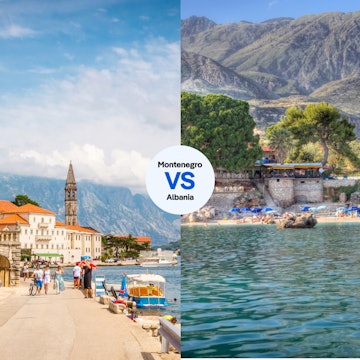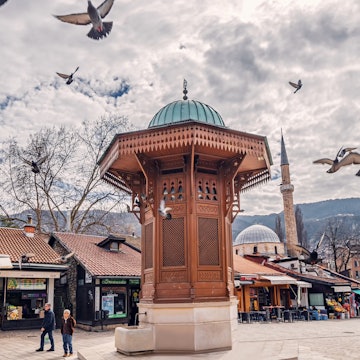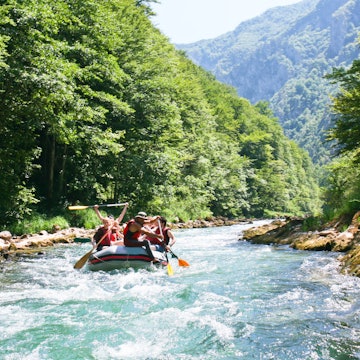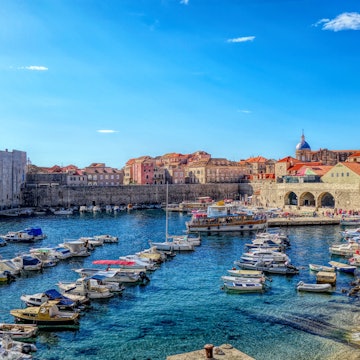
11 top day trips from Split to see more of Croatia


Split is the perfect hub for day trips along the Adriatic Coast © NataliaDeriabina / iStockphoto / Getty Images
Alongside nearby Dubrovnik, Split draws travelers to the glittering Adriatic Coast of Croatia in droves, and the many attractions within the Roman city walls are just the start of the allure. With idyllic islands scattered offshore and a hinterland studded with castles, medieval towns and national parks, this historic city is the perfect stop for those who like their city breaks with bonus day trips.
After discovering all the must-see attractions in Split, you’ll be hungry for more. That’s why three to five days is an ideal time to spend in the city. With a few days to spare, you can find your own island in the sun, splash in thundering waterfalls in the hills, and discover medieval townships away from the (sometimes maddening) downtown crowds. Spring is the best time to visit this idyllic stretch of coastline before the summertime hordes arrive.
Most of the day trips from Split don’t require any special preparation. Pack light, have your camera ready and enjoy the dazzling Adriatic charms. Just don’t forget to always carry swimming attire – the local beaches are irresistible.
Inexpensive car hire is available from local companies and there are excellent local bus services, so getting there and back at the end of the day is easy too. Here are our 11 favorite day trips from Split to explore more of the Adriatic Coast and see the best of Croatia.
1. Find medieval magic in Trogir
Travel time: 40 minutes
Just along the coast from Unesco-listed Diocletian’s Palace in Split is another wonderful World Heritage wonder – historic Trogir, fêted for its extraordinarily well-preserved Romanesque and Renaissance architecture and unique and beautiful location. The old town sits on a small island, separated by narrow channels from the mainland on one side and from forested Čiovo Island on the other. It's a charming jumble of imposing fortifications, leafy gardens and seafront promenades.
Trogir has a laid-back vibe, and is a lovely place to while away a few hours, either wandering through the narrow marble-paved streets or sitting in a seafront cafe watching the world go by. The town’s showpiece is St Lawrence’s Cathedral, which has some incredibly ornate and beautiful carvings around the door and inside the Chapel of St Ivan. The views from the tower are well worth the thigh-busting climb.
How to get to Trogir from Split: It takes about 40 minutes to drive west along the coast to Trogir from Split. There’s a direct intercity bus, or in summer you can catch the shuttle boat run by Bura Line.

2. Discover seafaring history in Omiš
Travel time: 30 minutes
The legendary pirates’ lair of Omiš has a dramatic location at the mouth of the Cetina river, where freshwater carves its way through a maze of towering limestone outcrops to reach the Adriatic sea. In the Middle Ages, pirates based here terrorized the surrounding coastal and island communities, using special ships known as sagittas, which had very shallow keels, allowing the pirates to withdraw beyond the underwater fortifications at the mouth of the river that kept larger ships out at sea.
The pirates constructed two medieval fortresses high above the town to protect it from attackers, and both can be visited for grand views over the town, if your legs can take the climb. It’s also well worth taking an excursion up the Cetina river; the most sedate option is a river cruise, stopping off in a riverside restaurant on the way to sample local specialties such as frogs, eels and snails.
To get the adrenaline pumping, sign up for whitewater rafting on the rapids a little further upstream. You’ll paddle your way through the turquoise waters of Cetina Canyon that carve a channel through a lush valley, with tall mountains on either side. Another exciting way to enjoy the spectacular scenery is shooting down the canyon by zipline. Eight wires of varying length and steepness zigzag through the gorge, crossing the river several times on the way.
How to get to Omiš from Split: Omiš is a 40-minute drive east of Split via the coastal highway. City bus 60 heads here every half hour from central Split.

3. Relax in charming island getaway Šolta
Travel time: 1 hour
Often overlooked by tourists in favor of its more famous neighbors, the bucolic island of Šolta is ideal for anyone who wants to get away from it all. The island’s most attractive settlements are the seaside towns of Maslinica and Stomorska, which wrap around pretty harbors at opposite ends of the island. Maslinica is the ritzier of the two, with a yacht marina and a luxurious hotel in a restored castle. Stomorska, the island’s oldest coastal settlement, has a more traditional vibe, and is a great place to eat a simple yet delicious lunch of grilled fish and vegetables right by the water.
Inland, the villages are less polished but no less charming, with cobbled streets and shuttered stone cottages, some worn and faded from centuries in the sun. Exploring them provides a great opportunity to sample the island’s local produce – bee and honey lovers will enjoy a visit to Tverdić Honey in Grohote, while top-quality olive oil is available at Olynthia in Gornje Selo. Also in Gornje Selo, Agroturizam Kaštelanac offers tastings of traditional dark red and innovative rose wines made with Dobričić grapes.
How to get to Šolta from Split: Ferry company Jadrolinija has several ferries and catamarans each day from Split to the port of Rogač. From there you can explore the island by bus, bicycle or even on foot.

4. Have a splash at the sublime Krka National Park
Travel time: 1 hour and 30 minutes
Extending along the scenic Krka River, Krka National Park runs from the Adriatic coast near Šibenik to the rugged mountains of the Croatian interior. It’s a magical place of waterfalls and gorges, with the river gushing at one point through a canyon 200m (656ft) deep. Along with Plitvice Lakes, Krka is among the best road trip stops in the heart of Croatia. The highlight of the park is an hour-long loop following boardwalks that connect islands in the emerald-green river, ending at the park's largest waterfall, Skradinski Buk.
This broad cascade drops almost 46m (151ft) before crashing into the lower lake, where visitors gather to splash and swim. Further north, the waterfalls of Roški Slap are best visited on a boat tour. They begin with shallow steps that continue in a series of branches and islets to become 23m-high cascades.
The area’s remoteness attracted monks who constructed several monasteries here. Occupying a peaceful position above the river, Krka Monastery is the most important monastery for the Serbian Orthodox faith. Visit mid-June to mid-October to have a national park guide show you around the Byzantine and Mediterranean architecture. At other times you're welcome to visit the church and wander the lakeside path.
How to get to Krka National Park from Split: Krka has five main entrances – at Skradin, Lozovac, Roški Slap, Krka Monastery and Burnum – and all are accessible by car but hard to reach by public transport. Allow about an hour to drive here from Split.
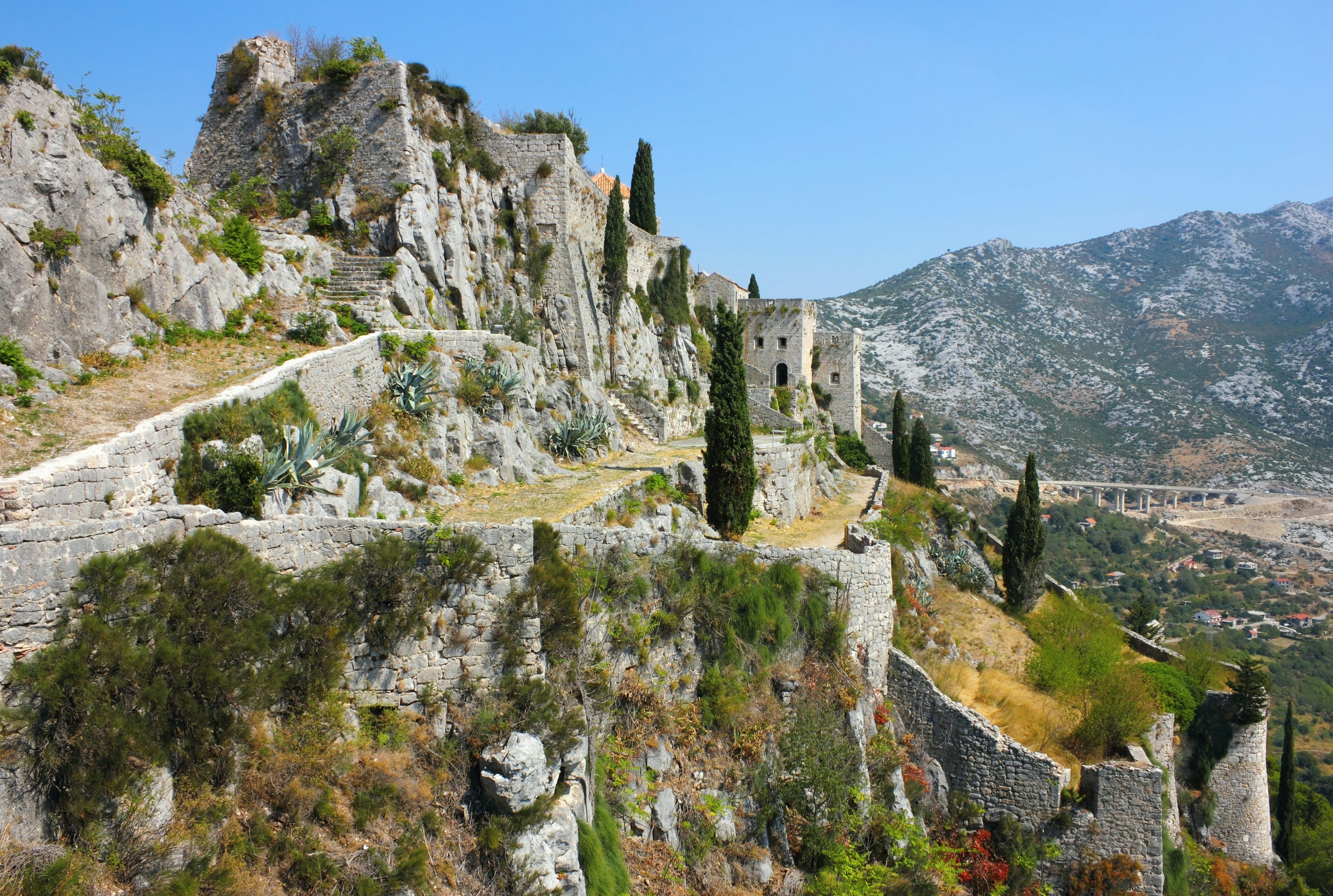
5. See cinematic views at Klis Fortress
Travel time: 30 minutes
Just 7 miles (12km) from the city center, Klis Fortress makes for a perfect day excursion from Split, combining an atmospheric and historic castle with impressive views over the Dalmatian coastline. The fortress is spectacularly located high on a ridge, defending the valley that leads to Split. Cobbled ramps and walls zigzag up the hillside, with the castle’s towers and ramparts piled precipitously on top.
The most dramatic event in the fortress’s history happened in 1537, when Ottoman invaders captured Klis from local defenders and mounted their captain’s severed head on a spike. More recently, Klis shot to fame as a Game of Thrones filming location – the terraces and ramparts stood in for the city of Meereen, where Daenerys vengefully crucified the city’s slave masters.
Exploring the ruined castle is great fun, and there are displays of historic armor and weapons in the armory, and Game of Thrones filming stills in the artillery barracks. The fortress is a good spot for a picnic too – you can admire the views of Split and the surrounding islands while gentle breezes keep you delightfully cool. Alternatively, head to the village of Klis Grlo, just below the castle, which is famous for its spit-roast lamb, which is sold by the kilo and eaten with spring onions.
How to get to Klis Fortress from Split: Klis Fortress is a 30-minute drive inland from Split, or you can catch a local bus from the city center, or visit on a guided tour.

6. Visit Hvar for a definitive Adriatic island experience
Travel time: 2 hours
With historic architecture, gorgeous swimming spots and lively nightlife, the beautiful island of Hvar is one of Croatia’s most popular destinations in its own right. Though it’s worth staying here at least a night or two if you can, it’s also possible to visit Hvar Island as a day trip from Split – you’ll want to get the fast catamaran direct to Hvar Town, the island’s largest and most charming settlement.
For a picture-perfect view of terracotta-roofed buildings clustered attractively around Hvar's square harbor, climb up to the ramparts of the medieval castle that looms high above the town. Then take a wander through the atmospheric streets of the old town, stopping to try the island’s delicious hvarska gregada (fish stew) at one of the harbor-side restaurants.
If you can tear yourself away from Hvar town, there are plenty of great ways to spend the rest of your day. Stroll along the seafront promenade to find yourself a great spot to swim in the crystal-clear waters of the Adriatic, or take a taxi boat out to one of the Pakleni Islands that lie just off the coast.
If you fancy something more active, & Adventure offers half-day kayaking, cycling and rock-climbing tours. Alternatively, get a feel for the less-visited interior of the island on a jeep safari through abandoned villages and lavender fields to the island’s highest point, where you can enjoy panoramic views of the whole island.
How to get to Hvar from Split: The fastest way to Hvar from Split is by catamaran, which takes just over an hour. In summer (June to September), the earliest departure from Split is at 8:30am with Jadrolinija with the last return at 9pm. Outside of the high season, if you want to visit Hvar from Split in a day, it’s probably best to take an organized tour.
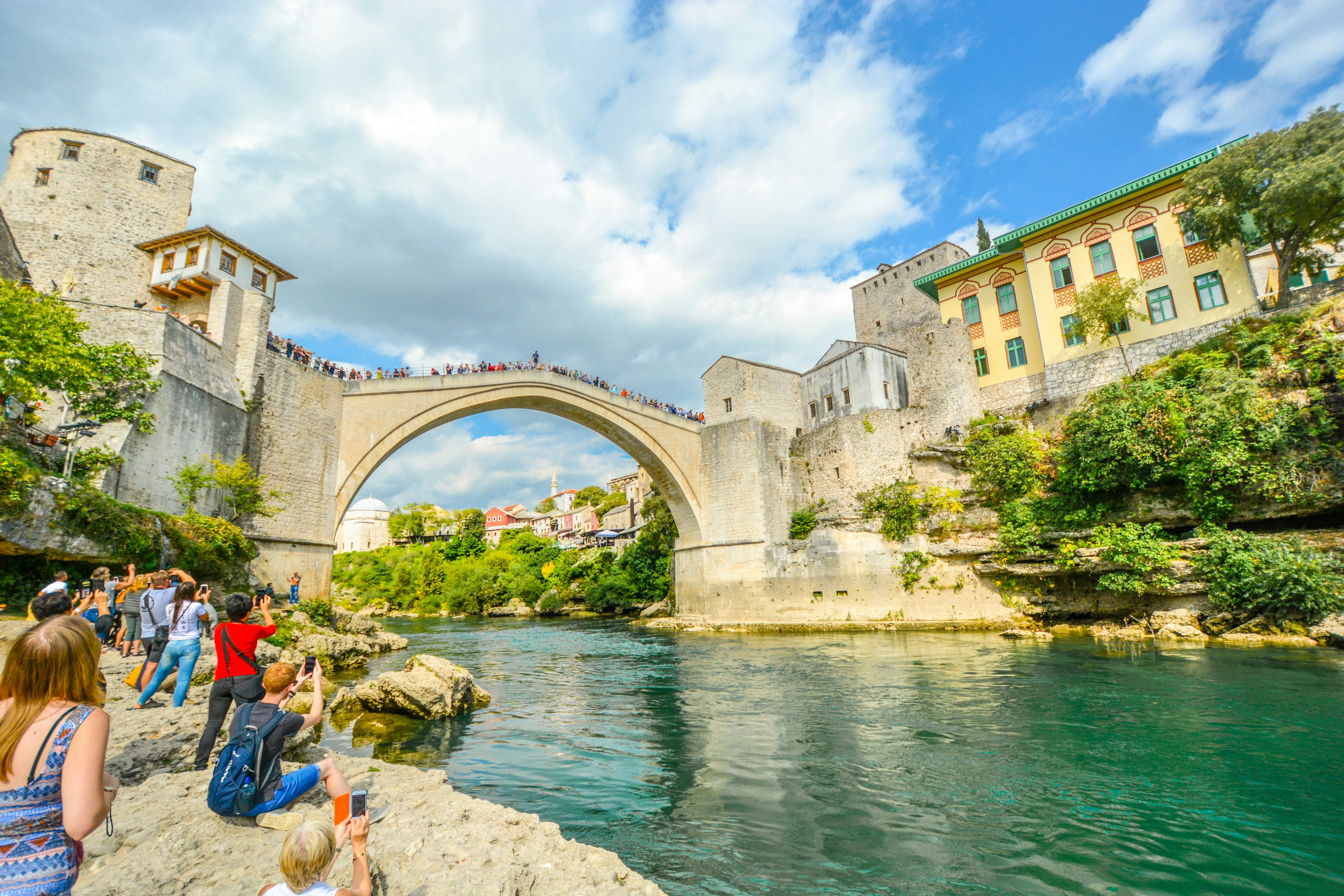
7. Find more medieval thrills at Mostar in Bosnia and Herzegovina
Travel time: 3 hours
This little cross-border jaunt will take you to Mostar, the largest city in Hercegovina, with a small but thoroughly enchanting old town center. Visitors gather to admire the Balkans' most celebrated bridge, Stari Most, which forms a majestic stone arc between medieval towers. The bridge's swooping arch was originally built between 1557 and 1566 on the orders of Suleiman the Magnificent.
In fact, the current structure is a very convincing 21st-century rebuild following the bridge's bombardment during the civil war in the 1990s. The span reopened in 2004 and is now a Unesco World Heritage site, famed for its bridge divers, who leap daringly into the deep waters 24m (79ft) below.
Make time for a stroll along narrow Kujundžiluk, where historical stone-roofed shop-houses bustle joyously with trinket sellers offering inexpensive souvenirs. Beyond the cobbled lanes of the attractively restored Ottoman quarter are whole blocks of bombed-out buildings, a poignant legacy of the 1990s conflict.
The summer welcomes hordes of day-trippers, so, if you're able to stay into the evening, you'll be able to enjoy the lights of numerous millhouse restaurants that twinkle across gushing streams at dusk without the daytime crush of people.
How to get to Mostar from Split: The city of Mostar is around a 2.5-hour drive from Split and the trip here crosses the Croatia–Bosnia border, so be sure to bring your passport and visas (if needed). There are bus services, but they can take up to 4 hours, so hiring a car is a better option.
8. Sail to the most famous beach in Croatia on Brač Island
Travel time: 1 hour and 30 minutes
Split’s strategic location in the middle of Dalmatia makes it a perfect base for island-hopping. One of the best destinations for beach lovers is the small town of Bol in the southern part of Brač Island. The trademark attraction is Zlatni Rat (or Golden Horn), a pebbly, horseshoe-shaped stretch of beach that changes its appearance with the tide. Pine trees flank the beach, the mountainous Brač landscape rises above, and the cozy cobblestone streets of Bol Old Town nearby invite exploration.
During summer, get to Zlatni Rat early in the morning to beat the crowds. In the afternoon the west thermic wind called Maestral makes the beach a popular windsurfing spot.
But this day trip isn’t only about the beach, as Bol possesses charms of its own. It’s a typical Croatian fishing village-turned-resort town with picturesque old stone houses, a romantic seaside promenade and a good selection of konobas (tavernas) serving local fare. Konoba Dalmatino is a classic choice with its harbor-faced terrace.
How to get to Bol from Split: Jadrolinija runs ferries from Split to Brač Island. There are car ferries to Supetar, a small town in the island’s north. You can also take a ferry directly to Bol. Alternatively, you can use the KSC catamaran to reach Zlatni Rat from Split in an hour.
9. Take a plunge at the Blue Lagoon of Veliki Drvenik
Travel time: 1 hour
Almost every country hugged by the Mediterranean Sea has a blue lagoon. You can easily reach this one from Split. The swimming spot is located on the coast of the island of Veliki Drvenik, just 30 minutes from Split via speedboat.
On a sunny day the water is incredibly clear and a beautiful azure hue. However, as with other blue lagoons across the world, overtourism is an issue here. During the peak season (July and August), the lagoon may become crowded with boats, making it not so idyllic. As such the best time to visit is May, June or September, when the water is warm enough to swim but the crowds are relatively low.
How to get to the Blue Lagoon from Split: The best way to get to the Blue Lagoon is on a boat tour. Check out GetYourGuide or Viator options. Some tours also include visiting nearby islands. Prices start from €50 (or $52) for a half-day trip. The closest blue cave attraction is on Biševo Island
10. Experience the mesmerizing beauty of Plitvice Lakes National Park
Travel time: 3 hours
Plitvice Lakes National Park is a must on Croatia itineraries and one of Europe’s bucket list places to visit. At Plitvice you enter a kingdom of cascading waterfalls and emerald waters. The panoramas resemble fantasy landscapes – except it’s all a very real (and fragile) ecosystem and Croatia’s largest and oldest national park.
Sixteen lakes cascade their way through the beautiful karst terrain, reaching a crescendo of roaring waterfalls. Visitors traverse wooden pathways to witness the show.
As with Dubrovnik – another ultra-popular Croatian destination – Plitvice Lakes receives millions of visitors yearly, and the park’s narrow pathways have their limits. Considering that there’s no bad time to visit the fairytale-looking lakes, coming during spring, autumn and winter gives you the most rewarding experience as there are no crowds.
How to get to Plitvice Lakes National Park from Split: The park is 150 miles from Split, so you’re looking at a full-day journey. There are direct buses to the national park’s Entrance 1 and Entrance 2. The ride takes approximately 3.5 hours and costs around €20 (or $21) one-way. Taking a rental car is a good alternative during the off-season. Opt for a guided day tour for the most hassle-free experience.
11. Explore one of Croatia’s most beautiful medieval cores in Šibenik
Travel time: 2 hours
Central Dalmatia’s third-largest town Šibenik is a fantastic day trip destination from Split if you want to learn more about Croatia’s history. While Hvar and Trogir are beautiful, they can also feel touristy. Šibenik has no crowds and comes with the same wow factor.
Its city center blends Venetian and Habsburg influences, and the epic medieval St. Michael's Fortress watches overhead. The must of the must-visits is the UNESCO-protected St James' Cathedral, a Renaissance treasure from architect Juraj Dalmatinac, built from the white stone of Brač Island.
Game of Thrones fans will recognize Šibenik as Braavos in the show’s fifth season.
How to get to Šibenik from Split: Šibenik is 50 miles north of Split and the two cities are connected by frequent buses. A trip by Flixbus takes 1.3 hours and tickets start from €9 (or $9.40) one way.
You might also like:
See the best of Croatia with this week-long itinerary
Are these the best places to visit in Croatia?
Where to find Game of Thrones tours and attractions after the finale
Anna Tyler traveled to Split in 2018 with support from the Croatian National Tourist Office. The article has since been updated with additional information. Lonely Planet contributors do not accept freebies in exchange for positive coverage.







